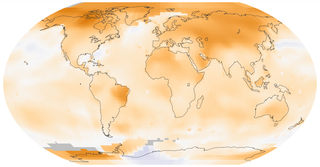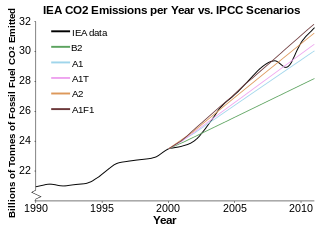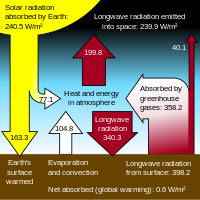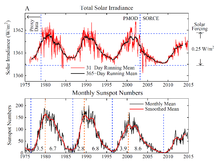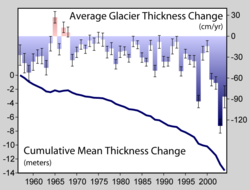Global mean surface temperature change from 1880 to 2014, relative to the 1951–1980 mean. The black line is the annual mean and the red line is the 5-year
running mean. The green bars show uncertainty estimates. Source:
NASA GISS.
World map showing surface temperature trends (°C per decade) between 1950 and 2014. Source:
NASA GISS.
[1]
Fossil fuel related
carbon dioxide (CO
2) emissions compared to five of the IPCC's "
SRES" emissions scenarios, published in 2000. The dips are related to global recessions. Image source:
Skeptical Science.
Fossil fuel related
carbon dioxide (CO
2) emissions over the 20th century. Image source:
EPA.
Global warming and
climate change are terms for the observed century-scale rise in the average temperature of the Earth's
climate system and its related effects.
Multiple lines of scientific evidence show that the climate system is warming.
[2][3] Although the increase of near-surface atmospheric temperature is the measure of global warming often reported in the popular press, most of the additional energy stored in the climate system since 1970 has gone into ocean warming. The remainder has melted ice, and warmed the continents and atmosphere.
[4][a] Many of the observed changes since the 1950s are unprecedented over decades to millennia.
[5]
On 12 November 2015,
NASA scientists reported that human-made
carbon dioxide (CO
2) continues to increase above levels not seen in hundreds of thousands of years: currently, about half of the carbon dioxide released from the burning of fossil fuels remains in the
atmosphere and is not absorbed by vegetation and the oceans.
[29][30][31][32]
Observed temperature changes
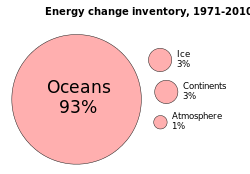
Earth has been in
radiative imbalancesince at least the 1970s, where less energy leaves the
atmosphere than enters it. Most of this extra energy has been absorbed by the oceans.
[33] It is very likely that human activities substantially contributed to this increase in
ocean heat content.
[34]
The global average (land and ocean) surface temperature shows a warming of 0.85 [0.65 to 1.06] °C in the period 1880 to 2012, based on multiple independently produced datasets.
[35] Earth's average surface temperature rose by
0.74±0.18 °C over the period 1906–2005. The rate of warming almost doubled for the last half of that period (
0.13±0.03 °C per decade, versus
0.07±0.02 °C per decade).
[36]
Trends
Temperature changes vary over the globe. Since 1979, land temperatures have increased about twice as fast as ocean temperatures (
0.25 °C per decade against
0.13 °C per decade).
[43] Ocean temperatures increase more slowly than land temperatures because of the larger effective
heat capacity of the oceans and because the ocean loses more heat by evaporation.
[44] Since the beginning of industrialisation the temperature difference between the hemispheres has increased due to melting of sea ice and snow in the North.
[45]Average arctic temperatures have been increasing at almost twice the rate of the rest of the world in the past 100 years; however arctic temperatures are also highly variable.
[46] Although more greenhouse gases are emitted in the Northern than Southern Hemisphere this does not contribute to the difference in warming because the major greenhouse gases persist long enough to mix between hemispheres.
[47]
The
thermal inertia of the oceans and slow responses of other indirect effects mean that climate can take centuries or longer to adjust to changes in forcing.
Climate commitment studies indicate that even if greenhouse gases were stabilized at year 2000 levels, a further warming of about 0.5 °C (0.9 °F) would still occur.
[48]
Global temperature is subject to short-term fluctuations that overlay long-term trends and can temporarily mask them. The relative stability in surface temperature from 2002 to 2009, which has been dubbed the
global warming hiatus by the media and some scientists,
[49] is consistent with such an episode.
[50][51] Recent updates to account for differing methods of measuring ocean surface temperature measurements show a significant positive trend over the recent decade.
[52][53]
Warmest years
Fourteen of the fifteen hottest years have been in the 21st century.
[54] While record-breaking years can attract considerable public interest, individual years are less significant than the overall trend. So some climatologists have criticized the attention that the popular press gives to "warmest year" statistics; for example,
Gavin Schmidt stated "the long-term trends or the expected sequence of records are far more important than whether any single year is a record or not."
[55]
Statistical uncertainty means that it is hard to separate years where the temperatures are close, so while 2014 had a greater chance than any other single year, it only has a 38% to 48% likelihood of being the warmest year on record since 1880.
[55][56] 2014 was the 38th consecutive year with above-average temperatures. Ocean oscillations like
El Niño Southern Oscillation (ENSO) can affect global average temperatures, for example, 1998 temperatures were significantly enhanced by strong El Niño conditions. 1998 remained the warmest year until 2005 and 2010 and the temperature of both of these years was enhanced by El Niño periods. However, 2014 was ENSO neutral.
Initial causes of temperature changes (external forcings)
Greenhouse effect schematic showing energy flows between space, the atmosphere, and Earth's surface. Energy exchanges are expressed in watts per square meter (W/m2).
This graph, known as the
Keeling Curve, documents the increase of atmospheric
carbon dioxide (CO
2) concentrations from 1958–2015. Monthly CO
2 measurements display seasonal oscillations in an upward trend; each year's maximum occurs during the
Northern Hemisphere's late spring, and declines during its growing season as plants remove some atmospheric CO
2.
Greenhouse gases
Annual world greenhouse gas emissions, in 2010, by sector.
Percentage share of global cumulative energy-related CO2 emissions between 1751 and 2012 across different regions.
On Earth, naturally occurring amounts of greenhouse gases have a mean warming effect of about 33 °C (59 °F).
[64][d] Without the Earth's atmosphere, the Earth's average temperature would be well below the freezing temperature of water.
[65] The major greenhouse gases are
water vapor, which causes about 36–70% of the greenhouse effect;
carbon dioxide (CO
2), which causes 9–26%;
methane (CH
4), which causes 4–9%; and
ozone (O
3), which causes 3–7%.
[66][67][68] Clouds also affect the radiation balance through
cloud forcings similar to greenhouse gases.
Human activity since the
Industrial Revolution has increased the amount of greenhouse gases in the atmosphere, leading to increased radiative forcing from CO
2, methane,
tropospheric ozone,
CFCsand
nitrous oxide. According to work published in 2007, the
concentrations of CO
2 and methane have increased by 36% and 148% respectively since 1750.
[69] These levels are much higher than at any time during the last 800,000 years, the period for which reliable data has been extracted from
ice cores.
[70][71][72][73] Less direct geological evidence indicates that CO
2 values higher than this were last seen about 20 million years ago.
[74] Fossil fuel burning has produced about three-quarters of the increase in CO
2 from human activity over the past 20 years. The rest of this increase is caused mostly by changes in land-use, particularly
deforestation.
[75] Estimates of global CO
2 emissions in 2011 from fossil fuel combustion, including cement production and gas flaring, was 34.8 billion tonnes (9.5 ± 0.5 PgC), an increase of 54% above emissions in 1990. Coal burning was responsible for 43% of the total emissions, oil 34%, gas 18%, cement 4.9% and gas flaring 0.7%
[76] In May 2013, it was reported that readings for CO
2 taken at the world's primary benchmark site in
Mauna Loasurpassed 400
ppm. According to professor
Brian Hoskins, this is likely the first time CO
2 levels have been this high for about 4.5 million years.
[77][78] Monthly global CO
2 concentrations exceeded 400 p.p.m. in March 2015, probably for the first time in several million years.
[79]
On 12 November 2015,
NASA scientists reported that human-made
carbon dioxide (CO
2) continues to increase above levels not seen in hundreds of thousands of years: currently, about half of the carbon dioxide released from the burning of fossil fuels remains in the
atmosphere and is not absorbed by vegetation and the oceans.
[29][30][31][32]
Emissions scenarios, estimates of changes in future emission levels of greenhouse gases, have been projected that depend upon uncertain economic,
sociological,
technological, and natural developments.
[85] In most scenarios, emissions continue to rise over the century, while in a few, emissions are reduced.
[86][87] Fossil fuel reserves are abundant, and will not limit carbon emissions in the 21st century.
[88] Emission scenarios, combined with modelling of the
carbon cycle, have been used to produce estimates of how atmospheric concentrations of greenhouse gases might change in the future. Using the six IPCC
SRES "marker" scenarios, models suggest that by the year 2100, the atmospheric concentration of CO
2 could range between 541 and 970 ppm.
[89] This is 90–250% above the concentration in the year 1750.
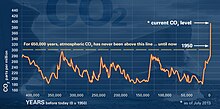
Atmospheric CO
2 concentration from 650,000 years ago to near present, using ice core proxy data and direct measurements.
Aerosols and soot

Ship tracks can be seen as lines in these clouds over the Atlantic Ocean on the east coast of the United States. Atmospheric particles from these and other sources could have a large effect on climate through the aerosol indirect effect.
Global dimming, a gradual reduction in the amount of global direct
irradiance at the Earth's surface, was observed from 1961 until at least 1990.
[93] Solid and liquid particles known as
aerosols, produced by volcanoes and human-made
pollutants, are thought to be the main cause of this dimming. They exert a cooling effect by increasing the reflection of incoming sunlight. The effects of the products of fossil fuel combustion – CO
2 and aerosols – have partially offset one another in recent decades, so that net warming has been due to the increase in non-CO
2greenhouse gases such as methane.
[94] Radiative forcing due to aerosols is temporally limited due to the processes that remove aerosols from the atmosphere.
Removal by clouds and precipitationgives
tropospheric aerosols an
atmospheric lifetime of only about a week, while
stratospheric aerosols can remain for a few years. Carbon dioxide has a lifetime of a century or more, and as such, changes in aerosols will only delay climate changes due to carbon dioxide.
[95]Black carbon is second only to carbon dioxide for its contribution to global warming.
[96]
In addition to their direct effect by scattering and absorbing solar radiation, aerosols have indirect effects on the
Earth's radiation budget. Sulfate aerosols act as
cloud condensation nuclei and thus lead to clouds that have more and smaller cloud droplets. These clouds reflect solar radiation more efficiently than clouds with fewer and larger droplets, a phenomenon known as the
Twomey effect.
[97] This effect also causes droplets to be of more uniform size, which reduces
growth of raindrops and makes the cloud more reflective to incoming sunlight, known as the
Albrecht effect.
[98] Indirect effects are most noticeable in marine stratiform clouds, and have very little radiative effect on convective clouds. Indirect effects of aerosols represent the largest uncertainty in radiative forcing.
[99]
Soot may either cool or warm Earth's
climate system, depending on whether it is airborne or deposited. Atmospheric soot directly absorbs solar radiation, which heats the atmosphere and cools the surface. In isolated areas with high soot production, such as rural India, as much as 50% of surface warming due to greenhouse gases may be masked by
atmospheric brown clouds.
[100] When deposited, especially on glaciers or on ice in arctic regions, the lower surface
albedo can also directly heat the surface.
[101] The influences of atmospheric particles, including black carbon, are most pronounced in the tropics and sub-tropics, particularly in Asia, while the effects of greenhouse gases are dominant in the extratropics and southern hemisphere.
[102]
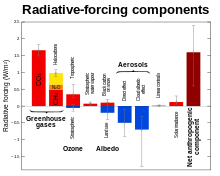
Contribution of natural factors and human activities to
radiative forcing of climate change.
[103] Radiative forcing values are for the year 2005, relative to the pre-industrial era (1750).
[103] The contribution of solar irradiance to radiative forcing is 5% the value of the combined radiative forcing due to increases in the atmospheric concentrations of carbon dioxide,
methane and nitrous oxide.
[104]
Solar activity
Since 1978,
solar irradiance has been measured by
satellites.
[105] These measurements indicate that the Sun's radiative output has not increased since 1978, so the warming during the past 30 years cannot be attributed to an increase in solar energy reaching the Earth.
Climate models have been used to examine the role of the Sun in recent climate change.
[106] Models are unable to reproduce the rapid warming observed in recent decades when they only take into account variations in solar output and volcanic activity. Models are, however, able to simulate the observed 20th century changes in temperature when they include all of the most important external forcings, including human influences and natural forcings.
Another line of evidence against the Sun having caused recent climate change comes from looking at how temperatures at different levels in the Earth's atmosphere have changed.
[107] Models and observations show that greenhouse warming results in warming of the lower atmosphere (called the
troposphere) but cooling of the upper atmosphere (called the
stratosphere).
[108][109] Depletion of the
ozone layerby chemical
refrigerants has also resulted in a strong cooling effect in the stratosphere. If the Sun were responsible for observed warming, warming of both the troposphere and stratosphere would be expected.
[110]
Variations in Earth's orbit
Orbital cycles vary slowly over tens of thousands of years, and at present are in a very slow cooling trend.
[111] The variations in orbital cycles may produce a
glacial period about 50,000 years from now.
[112]
Feedback
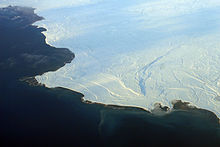
Sea ice, shown here in
Nunavut, in northern Canada, reflects more sunshine, while open ocean absorbs more, accelerating melting.
The climate system includes a range of
feedbacks, which alter the response of the system to changes in external forcings. Positive feedbacks increase the response of the climate system to an initial forcing, while negative feedbacks reduce the response of the climate system to an initial forcing.
[113]
Feedbacks are an important factor in determining the sensitivity of the climate system to increased atmospheric greenhouse gas concentrations. Other factors being equal, a higher
climate sensitivity means that more warming will occur for a given increase in greenhouse gas forcing.
[117] Uncertainty over the effect of feedbacks is a major reason why different climate models project different magnitudes of warming for a given forcing scenario. More research is needed to understand the role of clouds
[113] and carbon cycle feedbacks in climate projections.
[118]
The IPCC projections previously mentioned span the "likely" range (greater than 66% probability, based on expert judgement)
[6] for the selected emissions scenarios. However, the IPCC's projections do not reflect the full range of uncertainty.
[119] The lower end of the "likely" range appears to be better constrained than the upper end of the "likely" range.
[119]
Climate models
Calculations of global warming prepared in or before 2001 from a range of climate models under the
SRES A2 emissions scenario, which assumes no action is taken to reduce emissions and regionally divided economic development.
Projected change in annual mean surface air temperature from the late 20th century to the middle 21st century, based on a medium
emissions scenario(SRES A1B).
[120] This scenario assumes that no future policies are adopted to limit greenhouse gas emissions. Image credit:
NOAAGFDL.
[121]
A
climate model is a
representation of the physical, chemical and biological processes that affect the climate system.
[122] Such models are based on scientific disciplines such as
fluid dynamics and
thermodynamics as well as physical processes such as
radiative transfer. The models predict a range of variables such as local air movement, temperature, clouds, and other atmospheric properties; ocean temperature,
salt content, and
circulation; ice cover on land and sea; the transfer of heat and moisture from soil and vegetation to the atmosphere; and chemical and biological processes, among others.
Although researchers attempt to include as many processes as possible, simplifications of the actual climate system are inevitable because of the constraints of available computer power and limitations in knowledge of the climate system. Results from models can also vary due to different greenhouse gas inputs and the model's climate sensitivity. For example, the uncertainty in IPCC's 2007 projections is caused by (1) the use of multiple models
[119] with differing
sensitivity to greenhouse gas concentrations,
[123] (2) the use of differing estimates of humanity's future greenhouse gas emissions,
[119] (3) any additional emissions from climate feedbacks that were not included in the models IPCC used to prepare its report, i.e., greenhouse gas releases from permafrost.
[124]
The models do not assume the climate will warm due to increasing levels of greenhouse gases. Instead the models predict how greenhouse gases will interact with radiative transfer and other physical processes. Warming or cooling is thus a result, not an assumption, of the models.
[125]
Clouds and their effects are especially difficult to predict. Improving the models' representation of clouds is therefore an important topic in current research.
[126] Another prominent research topic is expanding and improving representations of the
carbon cycle.
[127][128][129]
Models are also used to help investigate the
causes of recent climate change by comparing the observed changes to those that the models project from various natural and human causes. Although these models do not unambiguously attribute the warming that occurred from approximately 1910 to 1945 to either natural variation or human effects, they do indicate that the warming since 1970 is dominated by man-made greenhouse gas emissions.
[60]
The physical realism of models is tested by examining their ability to simulate contemporary or past climates.
[130] Climate models produce a good match to observations of global temperature changes over the last century, but do not simulate all aspects of climate.
[131] Not all
effects of global warming are accurately predicted by the climate models used by the IPCC. Observed
Arctic shrinkage has been faster than that predicted.
[132] Precipitation increased proportionally to atmospheric humidity, and hence significantly faster than global climate models predict.
[133][134] Since 1990, sea level has also risen considerably faster than models predicted it would.
[135]
Observed and expected environmental effects

Projections of global mean sea level rise by Parris and others.
[136] Probabilities have not been assigned to these projections.
[137] Therefore, none of these projections should be interpreted as a "best estimate" of future sea level rise. Image credit: NOAA.
During the 21st century,
glaciers[140] and snow cover
[141] are projected to continue their widespread retreat. Projections of declines in Arctic sea ice vary.
[142][143] Recent projections suggest that Arctic summers could be ice-free (defined as ice extent less than 1 million
square km) as early as 2025-2030.
[144]
"Detection" is the process of demonstrating that climate has changed in some defined
statistical sense, without providing a reason for that change. Detection does not imply attribution of the detected change to a particular cause. "Attribution" of causes of climate change is the process of establishing the most likely causes for the detected change with some defined level of confidence.
[145] Detection and attribution may also be applied to observed changes in physical, ecological and social systems.
[146]
Extreme weather
Changes in regional climate are expected to include greater warming over land, with most warming at high northern
latitudes, and least warming over the
Southern Ocean and parts of the North Atlantic Ocean.
[147]
Future changes in
precipitation are expected to follow existing trends, with reduced precipitation over
subtropical land areas, and increased precipitation at subpolar latitudes and some
equatorial regions.
[148] Projections suggest a probable increase in the frequency and severity of some extreme weather events, such as
heat waves.
[149]
A 2015 study published in Nature, states:
About 18% of the moderate daily precipitation extremes over land are attributable to the observed temperature increase since pre-industrial times, which in turn primarily results from human influence. For 2 °C of warming the fraction of precipitation extremes attributable to human influence rises to about 40%. Likewise, today about 75% of the moderate daily hot extremes over land are attributable to warming. It is the most rare and extreme events for which the largest fraction is anthropogenic, and that contribution increases nonlinearly with further warming. [150][151]
Data analysis of extreme events from 1960 till 2010 suggests that droughts and heat waves appear simultaneously with increased frequency.
[152]
Sea level rise
Sea level rise, has been estimated to be on average +2.6 mm and +2.9 mm per year ± 0.4 mm since 1993. Additionally, sea level rise has accelerated in recent years.
[153] Over the 21st century, the IPCC projects for a high emissions scenario, that global mean
sea level could rise by 52–98 cm.
[154] The IPCC's projections are conservative, and may underestimate future sea level rise.
[155] Other estimates suggest for the same period that global mean sea level could rise by 0.2 to 2.0 m (0.7–6.6 ft), relative to mean sea level in 1992.
[136]
Widespread
coastal flooding would be expected if several degrees of warming is sustained for millennia.
[156] For example, sustained global warming of more than 2 °C (relative to pre-industrial levels) could lead to eventual sea level rise of around 1 to 4 m due to thermal expansion of sea water and the melting of glaciers and small
ice caps.
[156] Melting of the
Greenland ice sheet could contribute an additional 4 to 7.5 m over many thousands of years.
[156] It has been estimated that we are already committed to a sea-level rise of approximately 2.3 meters for each degree of temperature rise within the next 2,000 years.
[157]
Warming beyond the 2 °C target would potentially lead to rates of sea-level rise dominated by ice loss from Antarctica. Continued CO2 emissions from fossil sources could cause additional tens of meters of sea level rise, over the next millennia and eventually ultimately eliminate the entire Antarctic ice sheet, causing about 58 meters of sea level rise.
[158]
Ecological systems
In terrestrial
ecosystems, the earlier timing of spring events, and poleward and upward shifts in plant and animal ranges, have been linked with high confidence to recent warming.
[159] Future climate change is expected to particularly affect certain ecosystems, including
tundra,
mangroves, and
coral reefs.
[147] It is expected that most ecosystems will be affected by higher atmospheric CO
2 levels, combined with higher global temperatures.
[160] Overall, it is expected that climate change will result in the
extinction of many species and reduced diversity of ecosystems.
[161]
Increases in atmospheric CO
2 concentrations have led to an increase in
ocean acidity.
[162] Dissolved CO
2 increases ocean acidity, which is measured by lower
pH values.
[162]Between 1750 to 2000, surface-ocean pH has decreased by ≈0.1, from ≈8.2 to ≈8.1.
[163] Surface-ocean pH has probably not been below ≈8.1 during the past 2 million years.
[163]Projections suggest that surface-ocean pH could decrease by an additional 0.3–0.4 units by 2100.
[164] Future ocean acidification could threaten
coral reefs,
fisheries,
protected species, and other
natural resources of value to society.
[162][165]
Ocean deoxygenation is projected to increase
hypoxia by 10%, and triple suboxic waters (oxygen concentrations 98% less than the mean surface concentrations), for each 1 °C of upper Ocean warming.
[166]
Seismic activity
In recent studies, geologists claim that global warming is one of the reasons for increased seismic activity. According to these studies, melting glaciers and rising sea levels disturb the balance of pressure on Earth's tectonic plates thus causing increase in the frequency and intensity of earthquakes.
[167]
Long-term effects
On the timescale of centuries to millennia, the magnitude of global warming will be determined primarily by anthropogenic CO
2 emissions.
[168] This is due to carbon dioxide's very long lifetime in the atmosphere.
[168]
Stabilizing global average temperature would require reductions in anthropogenic CO
2 emissions.
[168] Reductions in emissions of non-CO
2 anthropogenic greenhouse gases (GHGs) (e.g., methane and nitrous oxide) would also be necessary.
[168][169] For CO
2, anthropogenic emissions would need to be reduced by more than 80% relative to their peak level.
[168] Even if this were achieved, global average temperatures would remain close to their highest level for many centuries.
[168]
Large-scale and abrupt impacts
Some large-scale changes could occur
abruptly, i.e., over a short time period, and might also be
irreversible. An example of abrupt climate change is the rapid release of
methane and
carbon dioxide from
permafrost, which would lead to amplified global warming.
[172][173] Scientific understanding of abrupt climate change is generally poor.
[174] The probability of abrupt change for some climate related feedbacks may be low.
[172][175] Factors that may increase the probability of abrupt climate change include higher magnitudes of global warming, warming that occurs more rapidly, and warming that is sustained over longer time periods.
[175]
Observed and expected effects on social systems
The
effects of climate change on human systems, mostly due to warming or shifts in
precipitation patterns, or both, have been detected worldwide. Production of wheat and maize globally has been impacted by climate change. While crop production has increased in some mid-latitude regions such as the UK and Northeast China, economic losses due to
extreme weather events have increased globally. There has been a shift from cold- to heat-related mortality in some regions as a result of warming. Livelihoods of
indigenous peoples of the Arctic have been altered by climate change, and there is emerging evidence of climate change impacts on livelihoods of
indigenous peoples in other regions. Regional impacts of climate change are now observable at more locations than before, on all continents and across ocean regions.
[176]
The future social impacts of climate change will be uneven.
[177] Many risks are expected to increase with higher magnitudes of global warming.
[178] All regions are at risk of experiencing negative impacts.
[179] Low-latitude, less developed areas face the greatest risk.
[180] A study from 2015 concluded that economic growth (
Gross domestic product) of poorer countries is much more impaired with projected future climate warming, than previously thought.
[181]
A meta analysis of 56 studies concluded in 2014 that each degree of temperature rise will increase violence by up to 20%, which includes fist fights, violent crimes, civil unrest or wars.
[182]
Examples of impacts include:
- Food: Crop production will probably be negatively affected in low latitude countries, while effects at northern latitudes may be positive or negative.[183] Global warming of around 4.6 °C relative to pre-industrial levels could pose a large risk to global and regional food security.[184]
- Health: Generally impacts will be more negative than positive.[185] Impacts include: the effects of extreme weather, leading to injury and loss of life;[186] and indirect effects, such as undernutrition brought on by crop failures.[187]
Habitat inundation

Map showing where natural disasters caused/aggravated by global warming may occur.
Economy
Estimates based on the IPCC A1B emission scenario from additional CO2 and CH4 grenhouse gases released from permafrost, estimate associated impact damages by US$43 trillion.
[191]
Possible responses to global warming
Mitigation

The graph on the right shows three "pathways" to meet the UNFCCC's 2 °C target, labelled "global technology", "decentralised solutions", and "consumption change". Each pathway shows how various measures (e.g., improved energy efficiency, increased use of renewable energy) could contribute to emissions reductions. Image credit: PBL
Netherlands Environmental Assessment Agency.
[192]
Near- and long-term trends in the global energy system are inconsistent with limiting global warming at below 1.5 or 2 °C, relative to pre-industrial levels.
[197][198] Pledges made as part of the
Cancún agreements are broadly consistent with having a likely chance (66 to 100% probability) of limiting global warming (in the 21st century) at below 3 °C, relative to pre-industrial levels.
[198]
In limiting warming at below 2 °C, more stringent emission reductions in the near-term would allow for less rapid reductions after 2030.
[199] Many integrated models are unable to meet the 2 °C target if pessimistic assumptions are made about the availability of mitigation technologies.
[200]
Adaptation
Other policy responses include
adaptation to climate change. Adaptation to climate change may be planned, either in reaction to or anticipation of climate change, or spontaneous, i.e., without government intervention.
[201] Planned adaptation is already occurring on a limited basis.
[194] The barriers, limits, and costs of future adaptation are not fully understood.
[194]
A concept related to adaptation is
adaptive capacity, which is the ability of a system (human, natural or managed) to adjust to climate change (including climate variability and extremes) to moderate potential damages, to take advantage of opportunities, or to cope with consequences.
[202] Unmitigated climate change (i.e., future climate change without efforts to limit greenhouse gas emissions) would, in the long term, be likely to exceed the capacity of natural, managed and human systems to adapt.
[203]
Environmental organizations and public figures have emphasized changes in the climate and the risks they entail, while promoting adaptation to changes in infrastructural needs and emissions reductions.
[204]
Climate engineering
Climate engineering (sometimes called by the more expansive term 'geoengineering'), is the deliberate modification of the climate. It has been investigated as a possible response to global warming, e.g. by
NASA[205] and the
Royal Society.
[206] Techniques under research fall generally into the categories
solar radiation management and
carbon dioxide removal, although various other schemes have been suggested. A study from 2014 investigated the most common climate engineering methods and concluded they are either ineffective or have potentially severe side effects and cannot be stopped without causing rapid climate change.
[207]
Discourse about global warming
Political discussion
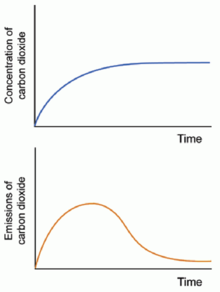
Article 2 of the UN Framework Convention refers explicitly to "stabilization of greenhouse gas concentrations."
[208] To stabilize the atmospheric concentration of
CO
2, emissions worldwide would need to be dramatically reduced from their present level.
[209]
Most countries are parties to the
United Nations Framework Convention on Climate Change (UNFCCC).
[210] The ultimate objective of the Convention is to prevent dangerous human interference of the climate system.
[211] As stated in the Convention, this requires that GHG concentrations are stabilized in the atmosphere at a level where
ecosystems can adapt naturally to climate change,
food production is not threatened, and
economic development can proceed in a sustainable fashion.
[212] The Framework Convention was agreed in 1992, but since then, global emissions have risen.
[213] During negotiations, the
G77 (a lobbying group in the United Nations representing 133 developing nations)
[214]:4 pushed for a mandate requiring developed countries to "[take] the lead" in reducing their emissions.
[215] This was justified on the basis that: the developed world's emissions had contributed most to the
stock of GHGs in the atmosphere;
per-capita emissions (i.e., emissions per head of population) were still relatively low in developing countries; and the emissions of developing countries would grow to meet their development needs.
[84]:290 This mandate was sustained in the
Kyoto Protocol to the Framework Convention,
[84]:290 which entered into legal effect in 2005.
[216]
In ratifying the Kyoto Protocol, most developed countries accepted legally binding commitments to limit their emissions. These first-round commitments expired in 2012.
[216] United States President
George W. Bush rejected the treaty on the basis that "it exempts 80% of the world, including major population centers such as China and India, from compliance, and would cause serious harm to the US economy."
[214]:5
At the
15th UNFCCC Conference of the Parties, held in 2009 at
Copenhagen, several UNFCCC Parties produced the
Copenhagen Accord.
[217][218] Parties associated with the Accord (140 countries, as of November 2010)
[219]:9 aim to limit the future increase in global mean temperature to below
2 °C.
[220] The
16th Conference of the Parties (COP16) was held at
Cancún in 2010. It produced an agreement, not a binding treaty, that the Parties should take urgent action to reduce greenhouse gas emissions to meet a goal of limiting global warming to
2 °C above pre-industrial temperatures. It also recognized the need to consider strengthening the goal to a global average rise of
1.5 °C.
[221]
Scientific discussion
Nearly all scientists agree that humans are contributing to observed climate change.
[81][222] At least 9 surveys of scientists and meta studies of academic papers concerning global warming have been carried out since 2004. While up to 18% of scientists surveyed might disagree with the consensus view, when restricted to scientists publishing in the field of climate, 97 to 100% agreed with the consensus. The consensus view being that most of the current warming is anthropogenic. See
Surveys of scientists' views on climate change. National science academies have called on world leaders for policies to cut global emissions.
[223]
In the scientific literature, there is a
strong consensus that global surface temperatures have increased in recent decades and that the trend is caused mainly by human-induced emissions of greenhouse gases. No scientific body of national or international standing
disagrees with this view.
[12][224]
Discussion by the public and in popular media
The
global warming controversy refers to a variety of disputes, substantially more pronounced in the
popular media than in the scientific literature,
[225][226] regarding the nature, causes, and consequences of global warming. The disputed issues include the causes of increased
global average air temperature, especially since the mid-20th century, whether this warming trend is unprecedented or within normal climatic variations, whether
humankind has contributed significantly to it, and whether the increase is wholly or partially an artifact of poor measurements. Additional disputes concern estimates of
climate sensitivity, predictions of additional warming, and what the consequences of global warming will be.
From 1990–1997 in the United States,
conservative think tanks mobilized to challenge the legitimacy of global warming as a social problem. They
challenged the scientific evidence, argued that global warming will have benefits, and asserted that proposed solutions would do more harm than good.
[227]
Surveys of public opinion
The world public, or at least people in economically advanced regions, became broadly aware of the global warming problem in the late 1980s. Polling groups began to track opinions on the subject, at first mainly in the United States.
[235] The longest consistent polling, by
Gallup in the US, found relatively small swings of 10% or so from 1998 to 2015 in opinion on the seriousness of global warming, but with increasing polarization between those concerned and those unconcerned.
[236]
The first major worldwide poll, conducted by Gallup in 2008-2009 in 127 countries, found that some 62% of people worldwide said they knew about global warming. In the advanced countries of North America, Europe and Japan, 90% or more knew about it (97% in the U.S., 99% in Japan); in less developed countries, especially in Africa, fewer than a quarter knew about it, although many had noticed local weather changes. Among those who knew about global warming, there was a wide variation between nations in belief that the warming was a result of human activities.
[237]
By 2010, with 111 countries surveyed, Gallup determined that there was a substantial decrease since 2007–08 in the number of Americans and Europeans who viewed global warming as a serious threat. In the US, just a little over half the population (53%) now viewed it as a serious concern for either themselves or their families; this was 10 points below the 2008 poll (63%). Latin America had the biggest rise in concern: 73% said global warming is a serious threat to their families.
[238] This global poll also found that people are more likely to attribute global warming to human activities than to natural causes, except in the US where nearly half (47%) of the population attributed global warming to natural causes.
[239]
A March–May 2013 survey by
Pew Research Center for the People & the Press polled 39 countries about global threats. According to 54% of those questioned, global warming featured top of the perceived global threats.
[240] In a January 2013 survey, Pew found that 69% of Americans say there is solid evidence that the Earth's average temperature has been getting warmer over the past few decades, up six points since November 2011 and 12 points since 2009.
[241]
A 2010 survey of 14 industrialized countries found that skepticism about the danger of global warming was highest in Australia, Norway, New Zealand and the United States, in that order, correlating with high per capita emissions of carbon dioxide.
[242]
Etymology
In the 1950s, research suggested increasing temperatures, and a 1952 newspaper reported "climate change". This phrase next appeared in a November 1957 report in
The Hammond Times which described
Roger Revelle's research into the effects of increasing human-caused CO
2 emissions on the
greenhouse effect, "a large scale global warming, with radical climate changes may result". Both phrases were only used occasionally until 1975, when
Wallace Smith Broecker published a scientific paper on the topic; "Climatic Change: Are We on the Brink of a Pronounced Global Warming?" The phrase began to come into common use, and in 1976
Mikhail Budyko's statement that "a global warming up has started" was widely reported.
[243] Other studies, such as a 1971
MIT report, referred to the human impact as "inadvertent climate modification", but an influential 1979
National Academy of Sciences study headed by
Jule Charney followed Broecker in using
global warming for rising surface temperatures, while describing the wider effects of increased CO
2 as
climate change.
[244]
In 1986 and November 1987,
NASA climate scientist
James Hansen gave testimony to Congress on global warming, but gained little attention. There were increasing heatwaves and drought problems in the summer of 1988, and when Hansen testified in the Senate on 23 June he sparked worldwide interest.
[245] He said: "global warming has reached a level such that we can ascribe with a high degree of confidence a cause and effect relationship between the greenhouse effect and the observed warming."
[246] Public attention increased over the summer, and
global warming became the dominant popular term, commonly used both by the press and in public discourse.
[244]
In a 2008 NASA article on usage,
Erik M. Conway defined
Global warming as "the increase in Earth’s average surface temperature due to rising levels of greenhouse gases", while
Climate change was "a long-term change in the Earth’s climate, or of a region on Earth."
As effects such as changing patterns of rainfall and rising sea levels would probably have more impact than temperatures alone, he considered "global climate change" a more scientifically accurate term, and like the
Intergovernmental Panel on Climate Change, the NASA website would emphasise this wider context.
[244]













 UN Environment
UN Environment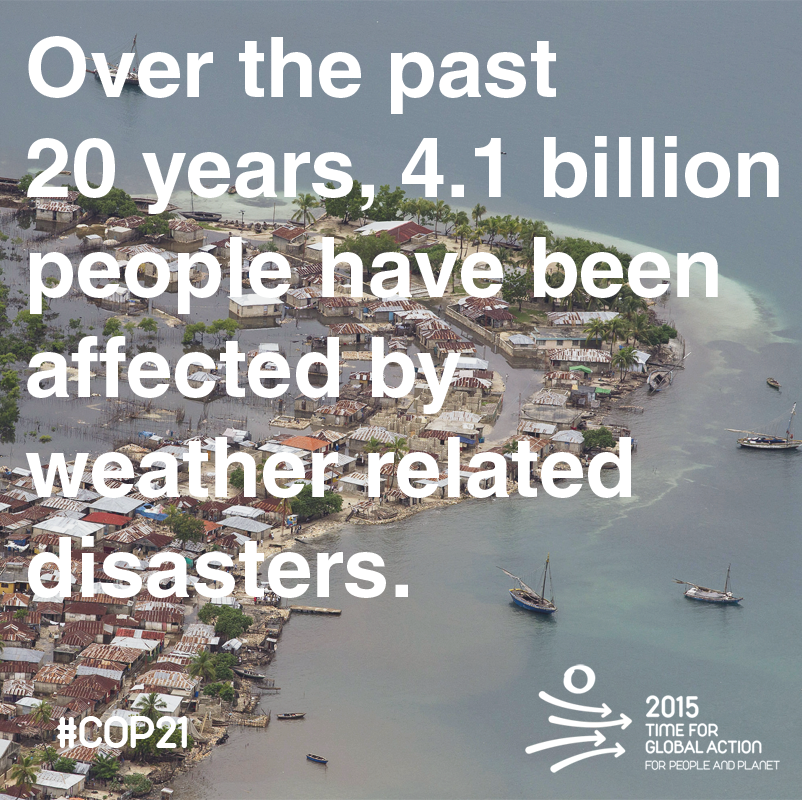
 Revista ISTOÉ
Revista ISTOÉ 
 VEJA
VEJA 
 Época
Época 


